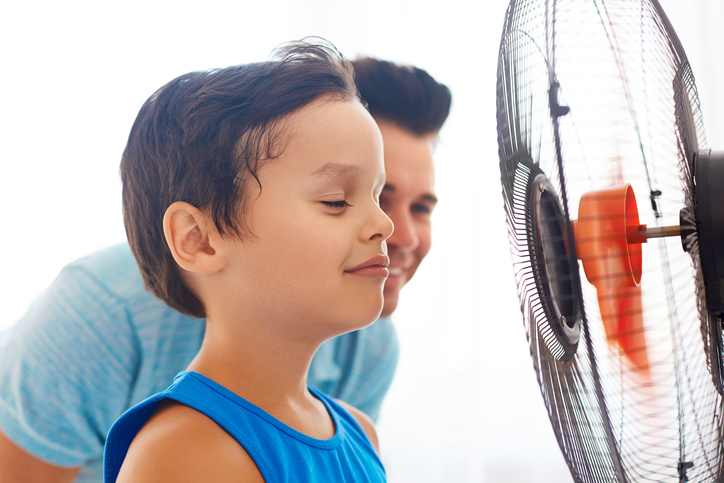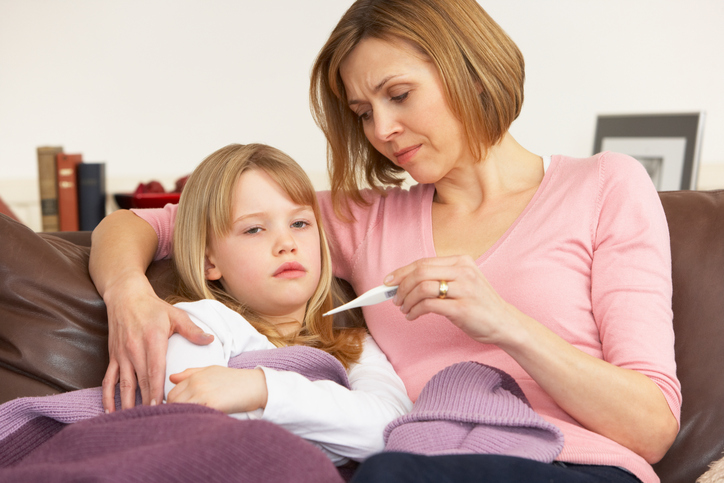Summer flu and colds in children. Do you know how to avoid them?

Although summer is not the typical season for colds and flu, it is often when they are unavoidable. The change from holidays or vacations to constant care for small patients is not pleasant for any family member. Do you know what the most common triggers of colds in summer are and how to avoid them?
Article content
Air conditioning and draughts
Part of improving comfort in the hot summer is using air conditioning, and not just in the car. It cools us down nicely and makes us feel full of energy again.
However, to avoid temperature shock and avoid ending up with a sore throat or headache, there are certain guidelines to follow.

Children are sensitive to sudden changes in temperature. Therefore, set the air conditioner no more than 6 degrees lower than the outside temperature. Never let the air flow directly on children, and certainly not on their faces.
Acclimatise before the end of the car journey. So gradually increase the temperature to bring it closer to the outside temperature. For short journeys, avoid using it altogether.
Using the air conditioning incorrectly or exposing your child to draughts can cause otitis media or conjunctivitis.
Remember that air conditioning not only cools the air but also dries it out. Subsequent drying of the mucous membranes can be prevented, for example, by leaving a container of water in the room. Drinking is also important.
Read also the following articles:
How to use, whether to set the air conditioner correctly and whether it does no harm?
Air conditioning and its effect on our health
What is thermal shock
During the hot summer period, we are constantly exposed to temperature differences. These are differences, for example, after entering air-conditioned shopping centres, when driving in an air-conditioned car, but also when bathing in cold water. Children are the most sensitive to these sudden changes.
The sudden transition from a cold to a hot environment and vice versa can lead to so-called temperature shock. As a result, the body loses its ability to defend itself, and not only against colds and flu. The immunity of young children in particular is reduced.
Temperature shock can also occur when cold drinks or icy treats such as popsicles and ice cream are consumed.
Overheating and heatstroke
In the heat of play and frolic, it is not only children who fail to notice the warning signs of overheating. Too much exposure to the sun not only risks sunburn, but also induces heat stroke or dehydration.
Proper use of air conditioning is preferable, even for a newborn, to leaving him or her in a hot environment with no airflow.
Also read articles on healthy sunbathing or sun protection.
Newborn babies have not yet developed thermoregulation, so they are not only more susceptible to hypothermia, but also to overheating or heat stroke. In addition, a warm and humid environment brings with it the risk of developing sweats, which sensitive baby skin encounters quite often.
In a ventilated room, the child sleeps better and is less at risk of sudden death syndrome. However, beware of draughts and thermal shock.
Remember:
Never leave your child alone in the car for even a few minutes! In the hot summer months, a stationary car can turn into a hot inferno in no time!
Summer flu
Influenza virus is the cause of the typical flu epidemics we are familiar with during spring and autumn. However, it is almost non-existent in the summer months. Summer flu or colds are mainly caused by enteroviruses. They usually present with a three-day fever and a mild sore throat. Vomiting, headache or muscle pain are also common.

Some of the factors that contribute to the onset of summer colds and flu include spending long periods of time in cold water, a combination of sweaty bodies and draughts, cold drinks, ice cream and so on. All of these cause the body to go into thermal shock and weaken its immunity.
Also, be careful with your fluid intake. A lack of fluids dries out the mucous membranes, which do not fulfil their protective function. Read also the article on the correct drinking regime in summer.
Make sure that the child is not exposed to draughts, especially when sweating.
We must also be careful when we are exposed to excessive sunlight. This weakens the body. It makes it more difficult for the body to defend itself against illness.
Don't leave children in cold water or wet swimsuits for long periods of time. Otherwise, you can give them not only a cold but also a urinary tract infection.
Treating summer flu
The treatment is basically the same as for the common cold or flu. It is important to give your child rest and rest. Make sure he or she gets enough fluids and, of course, vitamins. If the temperature is above 38.5 °C, give an antipyretic containing paracetamol or brufen. If the temperature does not drop within three days or if there are other complications or symptoms, you should see a doctor.
Angina
Upper respiratory tract infections are quite common in the summer. As with summer flu, not only children can easily go into thermal shock. Immunity drops suddenly. A drink that is too cold or too much ice cream is enough to cause a painful and unpleasant sore throat.
Angina is spread by droplet infection, i.e. sneezing and coughing by the sick person.
Depending on the localization of the inflammation, we distinguish pharyngitis or tonsillitis. Tonsillitis is called tonsillitis in purulent inflammation.
Tonsillar tissue has an important protective function in relation to the entry of disease-causing particles into the respiratory system.
Angina of bacterial origin occurs quite often in summer, because bacteria thrive most in the warm summer environment. However, staphylococci, viruses or fungi can also be the causative agent.

The treatment is differentiated according to the causative agent. Viral angina can be managed with bed rest, vitamins and plenty of fluids. However, with bacterial angina you cannot do without antibiotics. Of course, it is also important to keep the child calm and take plenty of fluids or vitamins. Your doctor may recommend antipyretics or painkillers. For viral angina, antivirals.
For sore throats, various lozenges or gargles commonly bought at the pharmacy will help. These have a local analgesic and antipyretic effect.
Tip: Read also the article.
How to cope with angina?
Children's ear canal is short, so they are more susceptible to otitis media than adults. It often occurs as a consequence or complication of an upper respiratory tract infection. It is therefore an associated disease, for example, with rhinitis or tonsillitis.
In the summertime, children are at risk of otitis externa, so-called external otitis. Long periods in the water or frequent diving contribute to the development of otitis externa. It is also known as swimmer's ear. In addition, a child's ear canal is directed slightly downwards from the middle towards the eardrum. Thus, water not only enters this area easily, but also stays there longer. These are important factors that promote inflammation.
You can also read more about ear infections not only in children in the article.
Urinary tract infections
Urinary tract infections do not escape even our little ones. Children under the age of three cannot urinate the entire volume of the bladder at once. Part of the urine remains in the bladder, which creates an ideal environment for bacteria to multiply. It is more common in girls. Their urethra is shorter and located only 1 centimeter from the anus. Thus, bacteria naturally found in the large intestine are not far from the urinary tract, where they cause inflammation.
However, boys are not exempt from these problems, especially when wearing wet swimsuits, sweaty clothes or urinating in the pool. When urinating, it is easier for microorganisms to enter the urinary tract and cause inflammation.
Read more in the article Urinary tract inflammation.
Also pay attention to the quality and cleanliness of the water in which children bathe. Pools or lakes that are not clean enough can cause problems not only in the urinary tract.
Read also this magazine article:
Swimming inponds and swimming pools poses health risks
Summary of summer problems in one magazine article
Ako podporiť imunitu u dojčiat a batoliat
Interesting resources
Related










